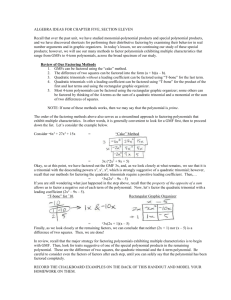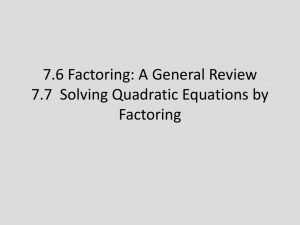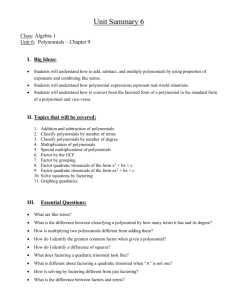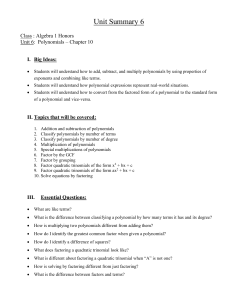Chapter 13
advertisement
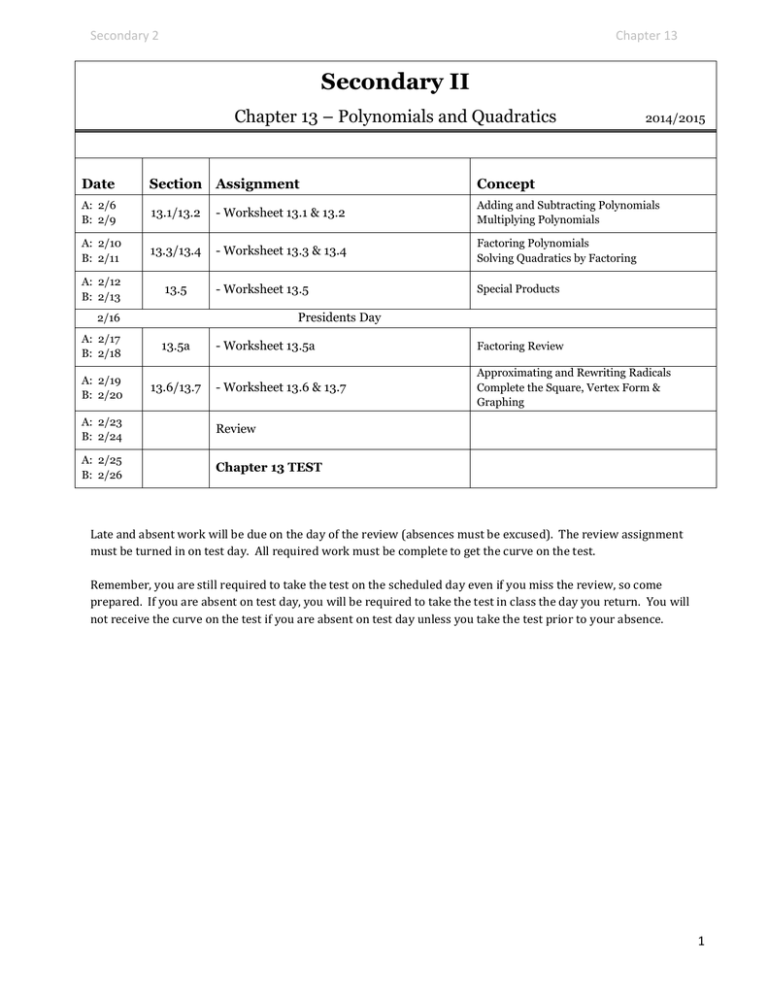
Secondary 2 Chapter 13 Secondary II Chapter 13 – Polynomials and Quadratics 2014/2015 Date Section Assignment Concept A: 2/6 B: 2/9 13.1/13.2 - Worksheet 13.1 & 13.2 Adding and Subtracting Polynomials Multiplying Polynomials A: 2/10 B: 2/11 13.3/13.4 - Worksheet 13.3 & 13.4 Factoring Polynomials Solving Quadratics by Factoring A: 2/12 B: 2/13 13.5 - Worksheet 13.5 Special Products Presidents Day 2/16 A: 2/17 B: 2/18 13.5a A: 2/19 B: 2/20 13.6/13.7 - Worksheet 13.5a Factoring Review - Worksheet 13.6 & 13.7 Approximating and Rewriting Radicals Complete the Square, Vertex Form & Graphing A: 2/23 B: 2/24 Review A: 2/25 B: 2/26 Chapter 13 TEST Late and absent work will be due on the day of the review (absences must be excused). The review assignment must be turned in on test day. All required work must be complete to get the curve on the test. Remember, you are still required to take the test on the scheduled day even if you miss the review, so come prepared. If you are absent on test day, you will be required to take the test in class the day you return. You will not receive the curve on the test if you are absent on test day unless you take the test prior to your absence. 1 Secondary 2 Chapter 13 2 Secondary 2 Chapter 13 Chapter 13: Polynomials and Quadratics 13.1/13.2 – Adding, Subtracting & Multiplying Polynomials (Standards: A.APR.1, F.BF.1.b, A.SSE.3.a, A.CED.1, A.CED.2) Previously, you worked with a number of expressions in the form 𝑎𝑥 + 𝑏 and 𝑎𝑥 2 + 𝑏𝑥 + 𝑐. Each of these is also part of a larger group of expressions known as polynomials. Polynomial: is a mathematical expression involving the sum of powers in one or more variables multiplied by coefficients. (A polynomial is written in standard form when the terms are in descending order by degree.) Polynomial in one variable: is the sum of terms of the form 𝑎𝑥 𝑘 , where a is any real number and k is a nonnegative integer. Term: a single number, a variable, or numbers and variables multiplied together, separated by addition and subtraction. Factors: numbers you can multiply together to get another number. Coefficient: a number used to multiply a variable. Constant: a number without a variable part. EXAMPLE: The polynomial 𝑚3 + 8𝑚2 − 10𝑚 + 5 has… 4 Terms : 𝑚3 , 8𝑚2 , 10𝑚, 𝑎𝑛𝑑 5 Coefficients: 1, 8, and -10 Constant: 5 Example 1: Analyze each polynomial. Identify the terms and coefficients in each. a. −2𝑥 2 + 100𝑥 b. 𝑥 2 + 4𝑥 + 3 c. 4𝑚3 − 2𝑚2 + 5 Terms: Terms: Terms: Coefficients: Coefficients: Coefficients: Polynomials are named according to the number of terms they have. Monomial only one term Binomial exactly two terms Trinomial exactly three terms Degree of a term: is the exponent of the term in the polynomial. Degree of a Polynomial: the greatest exponent in the polynomial. Example 2: Determine the degree of the polynomial. a. 4𝑥 − 6𝑥 2 2 b. − 3 c. 78𝑘 3 − 3 3 Secondary 2 Term 6x –2 1 𝑥2 √𝑥 Chapter 13 Polynomial? Reason This is NOT a polynomial term... This is NOT a polynomial term... This is NOT a polynomial term... Example 3: A scientist is responsible for tracking two species of endangered parrots, the Orange-bellied Parrot and the Yellow-headed Parrot. Suppose the Orange-bellied Parrots’ population can be modeled by the function 𝐵(𝑥) = −18𝑥 + 120, where x represents the number of years since the current year. Then suppose that the population of the Yellow-headed Parrot can be modeled by the function. 𝐻(𝑥) = 4 𝑥 2 − 5𝑥 + 25. The scientist needs to determine the total number of these endangered parrots over a six-year span. 1. Use the functions B(x) and H(x) to write an equation for T(x). 2. Predict the shape of the graph of T(x). Use a calculator to fill in the table below for each of the functions, then find the total number of parrots. Time Since Present (years) Number of Orange-bellied Parrots B(x) Number of Yellow-headed Parrots H(x) Total Number of Parrots T(x) -3 -2 -1 0 1 2 3 4 Secondary 2 Chapter 13 3. Sketch a graph of T(x) on the coordinate plane shown below. Use the values of T(x). Then connect the points with a smooth curve. 4. Did your sketch match your prediction in (b)? Describe the function family T(x) belongs to. You can calculate the total population of parrots using the two graphed functions. The graphs of the two polynomial functions are shown. 5. Use a graphing calculator to check your sketch by graphing B(x) and H(x) and then the sum of the two functions. To graph the sum of two functions, follow the steps below. In Y1, enter the function for 𝐵(𝑥). In Y2, enter the function for 𝐻(𝑥). In Y3, enter Y1 + Y2. To do this… Press VARS, move the cursor right to Y-VARS, (1: Function…) press ENTER Then 1: Y1 press ENTER Put in an addition sign, and then go through step 4 again. Instead of selecting 1:Y1 in step 5, move the cursor down one and select 2:Y2. 7. GRAPH 1. 2. 3. 4. 5. 6. 6. Write a function, T(x), in terms of x that can be used to calculate the total number of parrots at any time. 5 Secondary 2 Chapter 13 Example 4: Analyze the work. Determine the error and make the necessary corrections. a. b. c. Example 5: Determine the sum or difference of each. Show your work. a. ( 𝑥 2 − 2𝑥 − 3) + (2𝑥 + 1) 𝑐. (4𝑥 3 + 5𝑥 − 2) + (7𝑥 2 − 8𝑥 + 9) b. (2𝑥 2 + 3𝑥 − 4) − (2𝑥 2 + 5𝑥 − 6) d. (9𝑥 4 − 5) − (8𝑥 4 − 2𝑥 3 + 𝑥) So far, you have learned how to add and subtract polynomials. But what about multiplying polynomials? Let’s consider the binomials (x+1) and (x+2). You can use algebra tiles to model the two binomials and determine their product. 1. What is the product of (x+1)(x+2) ? 2. How would the model change if the binomial (x+2) was changed to (x+4). What is the new product of (x + 1) and (x + 4)? 6 Secondary 2 Chapter 13 Algebra tiles are one way to determine the product of polynomials, but they become difficult to use when the polynomials are more complex. Example 6: Todd was calculating the product of the binomials (4x + 7) and (5x – 3). He thought he didn’t have enough algebra tiles to determine the product. Instead, he performed the calculation using the model shown. 1. Determine the product of the binomials (3𝑢 + 17)(4𝑢 − 6) using multiplication tables. Write the product in standard form. Another method that can be used to multiply polynomials is called the FOIL method. The word FOIL indicates the order in which you multiply the terms. You multiply the First terms, then the Outer Terms, then the Inner terms, and then the Last terms. FOIL stands for First, Outer, Inner, Last. 7 Secondary 2 Chapter 13 Example 7: Determine each product, using any method. a. 2𝑥(𝑥 + 3) b. (𝑥 + 1)2 8 Secondary 2 c. Chapter 13 (𝑥 − 4)(2𝑥 + 3) d. (𝑥 − 5)(𝑥 2 + 3𝑥 + 1) d. (𝑥 2 − 2𝑥 + 1)(2𝑥 2 − 3𝑥 − 4) 9 Secondary 2 Chapter 13 Additional Notes 10 Secondary 2 Chapter 13 13.3 & 13.4 – Factoring Polynomials Solving Quadratics by Factoring (Standards: A.APR.1, A.SSE.2, A.SSE.3.a, A.REI.4.b) In the previous lesson, you multiplied polynomials. In this lesson, you will go in reverse and think about how to take a polynomial represented as the sum of terms and write an equivalent expression in factored form, if it is possible. To factor an expression means to rewrite the expression as a product of factors. In chapter 12, we learned how to factor out the GCF or Greatest Common Factor from a polynomial. This is always the first step when factoring. Practice 1: Factor out the greatest common factor for each polynomial, if possible. 4𝑥 + 12 b. 𝑥 3 − 5𝑥 c. 3𝑥 2 − 9𝑥 − 3 d. -𝑥 − 7 a. In the previous chapter, you used a graphing calculator to rewrite a quadratic expression in factored form, 𝑎𝑥 2 + 𝑏𝑥 + 𝑐 = 𝑎(𝑥 − 𝑟1 )(𝑥 − 𝑥2 ). Now, let’s find a strategy for factoring quadratic expressions without the use of technology. Example 1: Factor the trinomials. a. 𝑥 2 + 5𝑥 + 4 = b. 2𝑥 2 + 7𝑥 + 3 = 𝑥 2 − 5𝑥 + 4 = 2𝑥 2 − 7𝑥 + 3 = 𝑥 2 + 3𝑥 − 4 = 2𝑥 2 − 5𝑥 − 3 = 𝑥 2 − 3𝑥 − 4 = 2𝑥 2 + 5𝑥 − 3 = Example 2: Factor each trinomial completely. (Don’t forget to factor out the GCF, when possible!) a. 𝑥 2 + 5𝑥 − 24 c. 15 + 2𝑥 − 𝑥 2 b. 𝑥 2 + 10𝑥 + 25 d. x 2 7x 2 11 Secondary 2 Chapter 13 This time there is a term out front. Example 3: Factor the trinomials. a. 2𝑥 2 + 7𝑥 + 3 = 2𝑥 2 − 7𝑥 + 3 = 2𝑥 2 − 5𝑥 − 3 = 2𝑥 2 + 5𝑥 − 3 = Example 4: Factor each trinomial completely. (Don’t forget to factor out the GCF, when possible!) a. 2𝑥 2 − 3𝑥 − 5 b. 4𝑥 2 + 22𝑥 + 24 2 c. 5 x 13 x 6 d. 4𝑥 2 + 20𝑥 + 25 e. 6𝑥 2 − 𝑥 + 2 f. 8𝑥 2 + 22𝑥 + 5 g. −𝑏 2 + 9𝑏 − 20 = h. 3𝑦 3 − 27𝑦 2 − 30𝑦 = 12 Secondary 2 Chapter 13 The Zero Product Property states that if the product of two or more factors is equal to zero, then at least one factor must be equal to zero. If ab = 0, then a = 0 or b = 0. This is also referred to as the Converse of the Multiplication Property of Zero. 1. Use the Zero Product Property to determine the solutions of the quadratic equation 𝑥 2 − 4𝑥 − 5 = 0. Then, check your solutions by substituting back into the original equation. 2. Let’s examine the quadratic equation 0 = 𝑥 2 − 4𝑥 − 5. a. Graph the quadratic equation on the coordinate plane shown. b. Rewrite the equation in factored form. c. Identify the vertex, x- and y-intercepts, and the axis of symmetry. • y-intercept: • x-intercept(s): • axis of symmetry: • vertex: The solutions to a quadratic equation are called roots. The roots indicate where the graph of a quadratic equation crosses the x-axis. So, roots, zeros, and x-intercepts are all related. To calculate the roots of a quadratic equation using factoring: • Perform transformations so that one side of the equation is equal to zero. • Factor the quadratic expression on the other side of the equation. • Set each factor equal to zero. • Solve the resulting equations for the roots. Check each solution in the original equation. 13 Secondary 2 Chapter 13 3. Determine the roots or zeros of each quadratic equation, if possible. a. 𝑥 2 − 8𝑥 + 12 = 0 b. 𝑥 2 − 5𝑥 − 24 = 0 c. 𝑥 2 − 11𝑥 = 0 d. 𝑥 2 − 5𝑥 = 13𝑥 − 81 e. 3𝑥 2 − 22𝑥 + 7 = 0 f. 𝑓(𝑥) = 𝑥 2 − 7𝑥 − 18 14 Secondary 2 Chapter 13 Additional Notes 15 Secondary 2 Chapter 13 13.5 – Special Products (Standards: A.SSE.2, A.SSE.3.a) We also have special products when factoring. The first type of special product is called a perfect square trinomial. A perfect square trinomial is an expression in the form 𝑎2 + 2𝑎𝑏 + 𝑏 2 or in the form 𝑎2 − 2𝑎𝑏 + 𝑏 2 . A perfect square trinomial can be written as the square of a binomial. Example 1: Factor. (We did these last lesson!) a. 𝑥 2 + 10𝑥 + 25 b. 4𝑥 2 + 20𝑥 + 25 The second type of special product is called the difference of two squares. The difference of two squares is an expression in the form 𝑎2 − 𝑏 2 that can be factored as (a + b)(a - b). Example 2: Factor completely. a. 𝑥 2 − 𝑦 2 b. 4𝑎2 − 1 c. 𝑤 2 + 𝑥 2 d. 𝑥 4 − 9 e. 121𝑥 2 − 144 f. 16𝑥 4 − 1 Are Cubes Perfect Too? Earlier, you dealt with special products that had degrees of 2. There are also special products with degrees of 3. 1. Use a multiplication table to determine (𝑥 − 2)(𝑥 2 + 2𝑥 + 4). The product represents the difference of two cubes. The difference of two cubes is an expression in the form 𝑎3 − 𝑏 3 that can be factored as (𝑎 − 𝑏)(𝑎2 + 𝑎𝑏 + 𝑏 2 ). 16 Secondary 2 Chapter 13 Let’s consider the products of two more polynomials in factored form. 2. Use a multiplication table to determine (x + 2)(𝑥 2 − 2𝑥 + 4). The product represents the sum of two cubes. Previously you determined that you cannot factor the sum of two squares. You can factor the sum of two cubes. The sum of two cubes is an expression in the form 𝑎3 + 𝑏 3 that can be factored as (𝑎 + 𝑏)(𝑎2 − 𝑎𝑏 + 𝑏 2 ). Sum and Difference of Cubes Formulas a 3 b 3 = (a b)( a 2 ab b 2 ) a 3 b 3 = (a b)( a 2 ab b 2 ) Example 3: Factor each polynomial, if possible. a. 𝑥 3 + 8 b. 2𝑥 3 − 128 c. 2𝑥 3 − 16 d. 64 x 3 27 6 3 d. 8w x 17 Secondary 2 Chapter 13 Additional Notes 18 Secondary 2 Chapter 13 13.5a – Factoring Review Monomial Difference Two Perfect Squares Sum Binomial Factor Difference out any Two Perfect Cubes GCF Sum Perfect Square Trinomial Trinomial Generic Trinomial 𝑎𝑥 2 + 𝑏𝑥 + 𝑐 Polynomials with 4 or more terms 19 Secondary 2 Chapter 13 Examples: Factor each completely. 1. 𝑥 2 − 7𝑥 − 18 2. 5𝑝2 − 𝑝 − 18 3. 𝑢4 + 2𝑢2 4. 2𝑎4 − 6𝑎2 + 9 5. 4𝑚2 − 25 6. 125 − 𝑥 6 7. 8𝑥 4 + 27𝑥 8. 12𝑝3 − 21𝑝2 + 28𝑝 − 49 9. 3𝑥 4 + 12𝑥 3 − 3𝑥 2 − 12𝑥 10. 2𝑏 2 + 17𝑏 + 21 11. 343𝑏 2 − 7𝑏 4 12. −𝑎3 − 8 20 Secondary 2 Chapter 13 13.6 – Approximating and Rewriting Radicals (Standards: N.RN.2, A.CED.1, A.REI.4.b) Consider a guitar string that has a tension of 0.0026 pound per inch. An equation that relates hertz h and tension t in pounds per inch is ℎ2 = 𝑡. a. Determine the string tension if the frequency is 9.5 hertz. b. Determine the string tension if the frequency is 7.6 hertz. In earlier grades, you may have seen problems in which you only determined one square root. However, there are in fact two square roots for every whole number, a positive square root (which is also called the principal square root) and a negative square root. This occurs because of the rule you learned about multiplying two negative numbers: when two negative numbers are multiplied together, the product is a positive number. To solve the equation: ℎ2 = 81, √ℎ2 = ±√81 ℎ = ±9 However, you must still be mindful of the solutions in the context of the problem. Lincoln determined the frequency, in hertz, for a string with a tension of 121 pounds per inch. His work is shown. Explain why Lincoln is correct in the context of the problem. 21 Secondary 2 Chapter 13 You can also estimate the square roots of numbers that are not perfect squares. Example 1: You can determine the approximate value of √75. 1. What is the perfect square that is closest but less than 75? 2. What is the perfect square that is closest but greater than 75? 3. √75 must be between what two values? Example 2: Determine the approximate value for the following numbers. a. √42 b. √102 No! It Must Be Exact… There are times when an exact solution is necessary. For example, acoustical engineers may need to calculate the exact solution when designing sound stages or studios. 22 Secondary 2 Chapter 13 Example 3: For each given area, write an equation to determine the side measurements of the square acoustical tiles. Then, determine the exact side measurement of each square acoustical tile. a. 18 square inches b. 116 square inches Can extracting the square root also be used for expressions containing a variable and a constant term that are squared? Example 4: Determine the approximate solutions for each of the given equations. a. (𝑟 + 8 )2 = 83 b. (17 − 𝑑)2 = 55 23 Secondary 2 Chapter 13 13.7 – Complete the Square, Vertex Form and Graphing (Standards: A.SSE.3.b, A.REI.4.b, F.IF.7.a, F.IF.8.a) Example 1: Factor the quadratic function 𝑓(𝑥) = 𝑥 2 − 4𝑥 + 2 and determine the zeros, if possible. a. Graph the quadratic function from above, on your calculator. Sketch the graph on the coordinate plane. b. Does this function have zeros? Explain your reasoning. The quadratic function you graphed has zeros but cannot be factored, so we must find another method for calculating its zeros. Completing the square is a process for writing a quadratic expression in vertex form which then allows you to solve for the zeros. 1. Determine the unknown value of b or c that would make each expression a perfect square trinomial. Then write the expression as a binomial squared. a. 𝑥 2 − 8𝑥 + __________ = _______________ b. 𝑥 2 + 5𝑥 + __________ = _______________ c. 𝑥 2 − ________ + 100 = _______________ d. 𝑥 2 + __________ + 144 = _______________ 24 Secondary 2 Chapter 13 So how does completing the square help when trying to determine the roots of a quadratic equation that cannot be factored? We will first complete the square to obtain vertex form: 𝒚 = 𝒂(𝒙 − 𝒉)𝟐 + 𝒌 Examples: 1. y = x2 + 6x + 7 2. y = x2 +8x +10 From vertex form, we can determine more than just our vertex. Vertex: ( , ) Vertex: ( , ) AOS: AOS: Min/Max point? (ordered pair) Min/max point? (ordered pair) x-intercept(s): x-intercept(s): y-intercept(s): y-intercept(s): Vertical dilation: Vertical dilation: 25 Secondary 2 Chapter 13 More Practice completing the square! Complete the square to obtain the form y a( x h) k . 2 3. y x 5 x 4 4. y 3x 6 x 5 5. y 2 x 6 x 1 6. y x 6 x 3 2 2 2 2 26 Secondary 2 Chapter 13 Additional Notes 27

